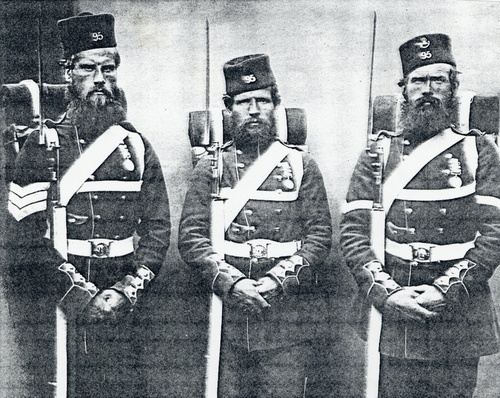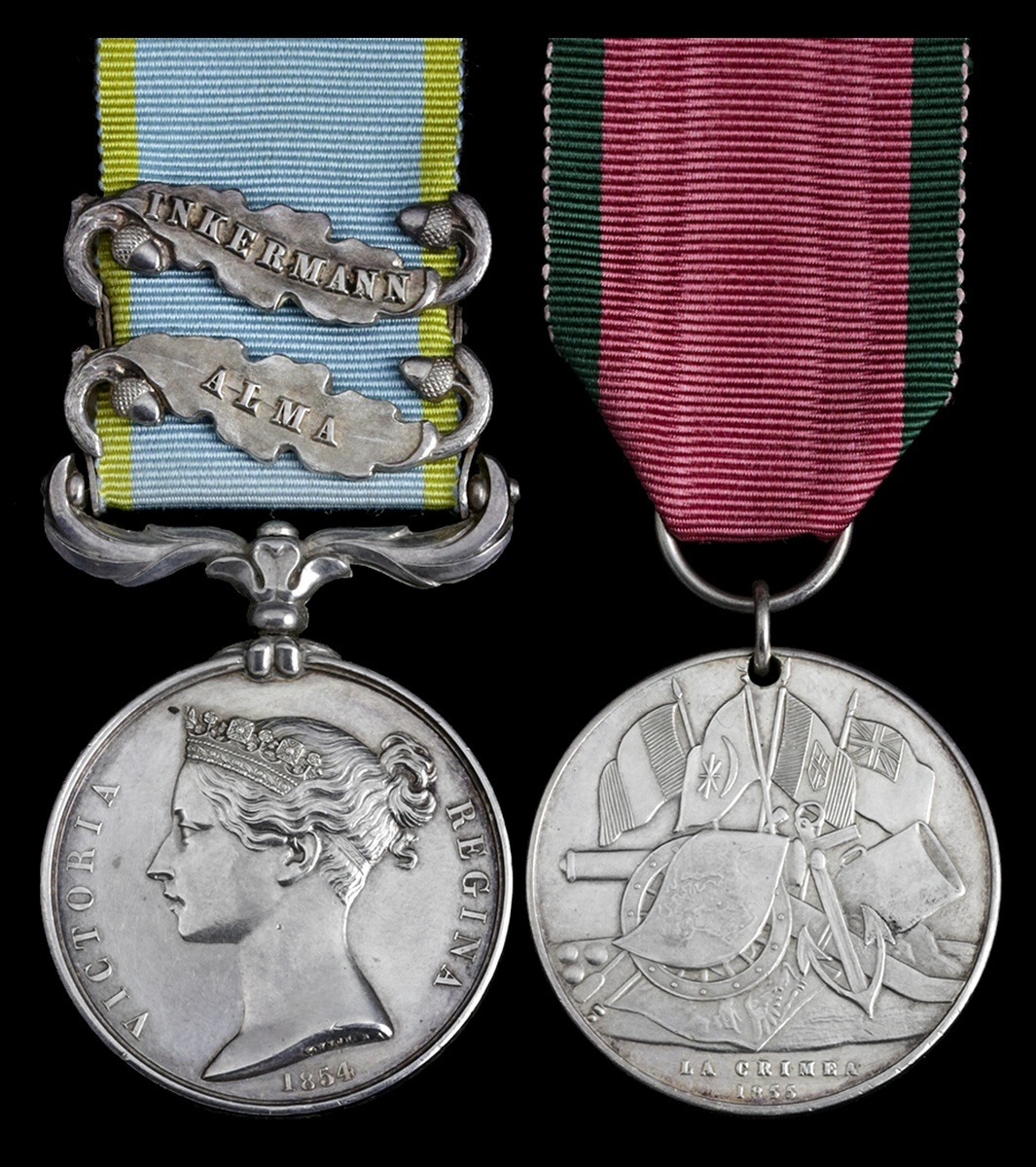Auction: 19001 - Orders, Decorations and Medals
Lot: 370
(x) The historically significant pair to Lieutenant-Colonel John George Champion, C.B., 95th Foot; having shown great bravery and initiative at the Alma, he commanded the forward picquets at Little Inkermann on 26 October, stoically defending The Barrier until British gunfire from Home Ridge forced the Russians to withdraw.
Champion is best remembered for his inspiring leadership at the Battle of Inkermann on 5 November, when with barely 100 men he defended the Sandbag Battery against huge Russian columns. In no way perturbed by the numbers facing them, his men charged with the bayonet and pursued their enemy into St. Clement's Ravine. Then, while attempting to control their impetuous ardour, Champion was shot in the chest.
Admitted to Scutari Hospital, he died a lingering death, never hearing of his well-merited promotion to Lieutenant-Colonel. An avid botanist, his name lives on in the plants named after him, not least Rhododendron Championae.
Crimea 1854-56, 2 clasps, Alma, Inkermann (Lieut. Coln. J. G. Champion. 95th Foot.), officially engraved by Hunt & Roskell in small serif capitals; Turkish Crimea, Sardinian issue, pierced with dual ring suspension, extremely fine (2)
[C.B.] London Gazette 10 July 1855.
John George Champion was born in Edinburgh on 5 May 1815, the eldest son of Major John Cary Champion, 21st Foot (Royal North British Fusiliers), and Elizabeth Herries, younger daughter of William Urquhart of Cranston Castle, Aberdeenshire. His father was killed on the island of St. Vincent in 1824 by a soldier who mistook him for another officer. After this tragedy, he returned to Scotland with his widowed mother.
Champion entered Sandhurst on 12 August 1828, aged just thirteen. He passed his public examination on 30 June 1831, and on 2 August 1832 was gazetted as an Ensign to the 95th (Derbyshire) Regiment of Foot. The Regiment was stationed in Cephalonia at the time, the Ionian Islands being under British protection. It was then in Ceylon from 1838 until 1847, when ordered to garrison Hong Kong. These exotic postings gave Champion ample opportunity to pursue his lifelong passion, botany. He collected numerous plant samples and sent them to the Royal Botanic Gardens, Kew. Rhododendron Championae is the most familiar plant named after him. His correspondence with Sir William Hooker and Professor Lindsay is preserved at Kew, and his plant-hunting discoveries were the nucleus of George Bentham's landmark Flora Hongkongiensis (1861).
Champion advanced to the ranks of Lieutenant in May 1835, Captain in October 1838, and Major in November 1851. He was second-in-command of the Regiment when, on 6 April 1854, it embarked at Portsmouth aboard the S.S. Medway, bound for Constantinople. Colonel J. Webber-Smith was in command. The Regiment's strength at the outset of the Crimean War was 32 officers and 901 sergeants and other ranks.
"Come, 95th, show them the way!"
At the Battle of the Alma (clasp) on 20 September 1854, the 95th was the leftmost regiment of De Lacy Evans's 2nd Division. Placed on the British right, this Division's objective was the 18-gun Russian battery atop Telegraph Hill, on the southern (enemy) bank of the Alma. Finally given the order to attack at 2 p.m., 2nd Division's line of march was obstructed by the village of Bourliouk, torched by Russian skirmishers in an attempt to delay the British advance. Observing events from an abandoned house, The Times correspondent William Howard Russell described the scene:
'At this moment the whole of our right was almost obscured by the clouds of black smoke from the burning village, and the front of the Russian line above us had burst into a volcano of flame and white smoke - the roar of the artillery became terrible - we could hear the heavy rush of the shot, those terrible dumps in the ground, and the crash of the trees, through which it tore with restless fury and force.'
With all momentum lost, 2nd Division's knotted formations were exposed to the fire of Russian guns, which decimated the 95th. Champion's commanding officer, Colonel Webber-Smith, was shot through the right leg and taken to the rear. Major Champion quickly took command. Whereas most of 2nd Division's regiments sought cover in walled vineyards lining the Alma's north bank, Champion would have none of this. With a cry of "Come, 95th, show them the way!" he led his men around the left side of the burning village and gained the far bank. Linking up with the 7th and 23rd Fusiliers, the 95th joined the assault on the Great Redoubt. Captain Heyland of the 95th captured a 32-pound brass howitzer, while Private James Keenan took the Regiment's Queen's Colour from a wounded ensign and planted it triumphantly on the earthwork.
In his despatch on the battle, Lord Raglan described the loss to the 95th Foot as 'immense'. Every ensign had been killed in succession, along with five sergeants who bravely defended the Queen's Colour as the Russian Vladimir Regiment counter-attacked. Champion was praised by Lord Raglan for his initiative and daring leadership (London Gazette, 17 November 1854). Though Champion was not returned as wounded, he stated in a letter of 3 October that: 'My arm was black and blue the next day from the fragment of a shell.'
Little Inkermann
Having driven the Russians back on Sebastopol, the Allies undertook the 'Flank March', one of the most remarkable feats of the campaign. With few maps and working mostly by compass, 50,000 men were marched 80 miles through dense woodland, converging simultaneously on the port of Balaklava on the Crimea's southern coast. Balaklava Harbour was vital to the British army's sustenance, but in protecting it the British became dangerously overstretched. When parallels were dug for the Siege of Sebastopol, six miles to the north-east, the exposed right flank was held only by the 2nd Division, already badly depleted from the Alma. The Division's position centred around 'Home Ridge', an improvised earthwork with embrasures for cannon. This defensive line sat atop a steep and barren ridge named after a ruined village across the River Tchernaya below. Its name was Inkermann.
At dawn on 26 October, Major Champion commanded the three companies of Pennefather's Brigade assigned to picquet duty before Home Ridge. To his astonishment, six Russian battalions under Colonel Federoff, with four light guns in support, suddenly appeared on Shell Hill, a northern promontory of Inkermann. The first picquets to fire upon the Russians were those of Lieutenant John Conolly, 49th Foot. After delivering a lethal Minie volley, Conolly's men were overwhelmed by sheer weight of numbers. Champion rushed his men over to Shell Hill and resisted the Russian advance just long enough for the British artillery to get into position on Home Ridge. Champion then extricated his tiny command, some 240 men, and took up a defensive position at 'The Barrier', a barricade blocking the main Post Road. He described the action (Wylly 1899, 24):
'…we defended ourselves vigorously against the swarms of Russians now appearing everywhere but in our rear. We stood with artillery and rifles until all our ammunition was at the last ebb. I knew that succour must come shortly, and sent to say how hard we were pressed. Then I told the men that supports were coming up to us, and I made them fix bayonets, which daunted the Russians, who had nearly driven us out by turning one flank. I tried to get up a charge but it was too much for human nature and the few men I had with me; but they advanced a little, firing a few shots, and the Russians fell back. Then came the cheering sound of our guns crowning the hill behind us, and pouring showers of grape.'
The accurate fire of Champion's men, coupled with the storm of lead from Home Ridge, was too much for the massed Russian columns, which scattered in confusion. They nevertheless brought back vital intelligence on the British position. This action, known as 'Little Inkermann', was merely a feint for the main Russian attack on 5 November.
'A most brave soldier'
As dawn broke on Sunday 5 November, over 40,000 Russian troops under Generals Soimonoff and Pauloff launched an attack on Inkermann ridge. Their aim was to turn the weak British right flank, thus breaking the Siege of Sebastopol. Champion and the 95th were initially held in reserve at 2nd Division's camp, behind Home Ridge. The Regiment's strength was now just ten officers and 433 non-commissioned officers and men, with Champion in command.
At 6.45 a.m. General Pennefather ordered the 95th to reinforce the Sandbag Battery, a disused earthwork in advance of Home Ridge. The Sandbag Battery had symbolic rather than tactical importance, and was fiercely contested throughout the day. Joined by the Guards Brigade, Champion's men took part in the heroic defence of the earthwork, charging repeatedly against oncoming columns (Mercer 1998, 108). Champion held the Sandbag Battery while other regiments, following Sir George Cathcart's example, pursued the fleeing Russians into Quarry Ravine. Now left alone and barely 100 strong, the 95th saw a heavy column of Russians moving up St. Clement's Gorge. They were looking down on this column when an unidentified voice called "Charge!" Despite being vastly outnumbered, this small party fell upon the startled Russians, forcing them back to the opposite slope. Champion was shot through the chest while trying to control his men's impetuous ardour. He fell instantly.
Conveyed onboard the steamer Sydney to Scutari Hospital, he lingered - tended with the utmost devotion by his servant, No. 2068, Private Harper, of the Grenadier Company - until his death on 30 November, at the early age of 39. He never lived to hear of his well-merited promotion to Lieutenant-Colonel, gazetted on 12 December. The London Gazette of 10 July 1855 stated that if Champion had survived, he would have been made a Companion of the Bath. Captain Sargent, his great friend, wrote in a letter to his widow:
'And thus your husband died as he had lived - gentle and forebearing, a true, good Christian man, a thorough gentleman, and a most brave soldier.'
A plain marble tomb marks the spot where Champion's body lies, in the cemetery at Scutari.
Sold with an extensive and fascinating archive, including:
(i)
Champion's collected letters, published under the title: A Sketch of the Life of the late Lieutenant-Colonel Champion, of the 95th Regiment (Kessinger Legacy Reprints, 2010).
(ii)
Five folders of copied research, compiled from several sources, with London Gazette entries, mentions in despatches, transcribed letters and photographs.
Reference works:
Bentley, N., ed., Russell's Despatches from the Crimea (London, 1966).
Mercer, P., Give Them a Volley and Charge! The Battle of Inkermann, 1854 (Staplehurst, 1998).
Wylly, Maj. H. C., 95th (The Derbyshire) Regiment in the Crimea (London, 1899).
Subject to 5% tax on Hammer Price in addition to 20% VAT on Buyer’s Premium. For more information please view Terms and Conditions for Buyers.
Sold for
£3,100







